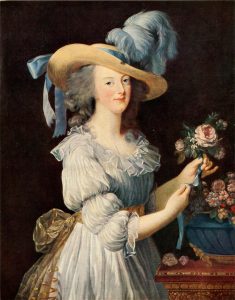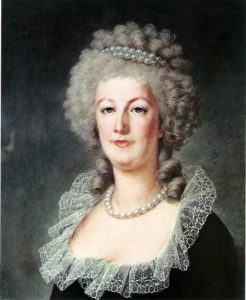6 Marie Antoinette, Queen of France

Ruled 1774-1792
November 2, 1755—October 16, 1793
Maria Antonia Josepha Johanna was born an Archduchess of Austria and was the penultimate child and youngest daughter of Empress Maria Theresa and Francis I, Holy Roman Emperor. She became Dauphine of France in May 1770 at age 14 upon her marriage to Louis-Auguste, heir apparent to the French throne. The arranged marriage sealed an alliance between longstanding enemies, Maria Theresa and Louis XVI, who hoped to thwart the ambitions of Prussia and Great Britain. She was married by proxy to the Dauphin on April 19 in Vienna and was formally wed to Louis-Auguste at Versailles on May 16, 1770. Four years later, Louis-Auguste ascended to the throne as Louis XVI with Marie Antoinette as his 18-year-old queen.
Although initially popular with the court and the people of France as the Dauphine, Marie Antoinette’s luxurious lifestyle—and Austrian heritage—eventually earned her enemies at court and she became a symbol of royal excess among the population. Louis XVI gave her a palace at Versailles, the Petite Trianon (originally commissioned by Louis XV for Madame Du Barry, who died before its completion) to do with as she pleased. It became her refuge from the formality of the Versailles court and was known as the Queen’s domain where even the king had to ask permission to visit. She spent heavily on clothes, entertainments, and gambling at a time of economic crisis when many of the population were in dire straits. She and her ladies at court adopted the English fashion of wearing dresses made of indienne, which had been banned to protect the French textile industry. She was also known to wear dresses of muslin, a flimsy material which resembled an undergarment, leading to rumors that the queen was indulging in sexual as well as monetary excesses among the young men and women she gathered around her at the Petite Trianon. A portrait of her wearing a muslin dress painted by Élisabeth Vigée Le Brun (fig. 1) caused a public uproar when it was exhibited and had to be removed and replaced with one of her wearing a more respectful gown. At a time when the population was rioting due to the high cost of flour and, hence, bread, Marie Antoinette wore elaborate, exaggerated headdresses or poufs up to three feet high which were powdered with flour. Although she never said, “Let them eat cake,” when told of the plight of the French people, her behavior, nevertheless, contributed to the swiftness with which the rumored utterance circulated and was believed. Her mother the Empress Marie Theresa often wrote to her warning of the dangers of her excesses.
Adding to her unpopularity was her childlessness. Eventually, having consulted her elder brother the Emperor Joseph II on his incognito visit to court, she and Louis consummated their marriage and on December 19, 1778, Marie Antoinette’s daughter, Marie-Thérèse Charlotte, Madame Royale, was born at Versailles. She was the first of four children Marie Antoinette would bear and the only child to survive the French Revolution. In October of1781, she gave birth to the Dauphin, the presumptive heir to the throne, to the great relief of the French people. However, the general air of celebration that accompanied his birth would not last. When Marie Antoinette’s second son was born, it was rumored that his father was, in fact, the Swede Count Axel von Fersen, one of the Queen’s coterie of young nobles who gathered at the Petite Trianon. Marie Antoinette’s spending at the Petit Trianon (where she caused to be built le hameau de la reine, the Queen’s hamlet, a faux country village) and the King’s purchase of the Chateau de Saint-Cloud for his wife for the sum of six million livres further cemented in the populace’s mind that Marie Antoinette was the cause of the country’s massive deficit. In fact, she was called Madame Deficit in the papers. Her last child, Madame Sophie, was born in 1786 but only lived for eleven months.
Another event in 1787 proved disastrous for the queen as well. A group of persons including the descendant of the illegitimate daughter of Henry II of France conspired to defraud jewelers Boehmer and Bassenge of the price of an expensive diamond necklace they had originally created for Madame du Barry. One of the conspirators was a prostitute who happened to look like Marie Antoinette. Although most of the persons involved were either exiled or imprisoned, one of the accused, the Cardinal de Rohan, was found innocent of all charges. Marie Antoinette, who had disliked him since his time as the French Ambassador to Vienna when she was a child, had vigorously insisted on his arrest. His release was a grievous blow against her and the monarchy.
When Louis was forced to call the Estate-General in 1789, Marie Antoinette urged him to remain steadfast in the face of the nobility’s resistance. A conservative who believed in the absolute right of the monarchy to rule, Marie Antoinette thought that, in time, the king would bring the population to heel. Although she had previously begun to live a less lavish lifestyle and devoted herself to her children, she now became one of Louis’ prime advisers, a role she would fill until Louis XVI’s execution.
Marie Antoinette was found guilty of treason and executed on October 16, 1793. She was thirty-seven years old. Her remains, like those of her husband, were interred in the Madeleine Cemetery. Their bodies were exhumed by order of Louis XVIII during the restored Bourbon monarchy in 1816 and buried in the traditional crypt of French kings in the Cathedral of St. Denis.

Bibliography of Sources:
Bashor, Will. Marie Antoinette’s Head: The Royal Hairdresser, the Queen, and the Revolution. Guilford, Conn.: Lyons Press, 2013.
Chrisman-Campbell, Kimberly. Fashion Victims: Dress at the Court of Louis XVI and Marie-Antoinette. New Haven: Yale University Press, 2015.
“Marie Antoinette.” Wikipedia: The Free Encyclopedia. Accessed April 14, 2019. https://en.wikipedia.org/wiki/Rose_Bertin.
“Marie Antoinette.” Palace of Versailles. Accessed May 20, 2019. http://en.chateauversailles.fr/discover/history/great-characters/marie-antoinette.
Tulard, Jean. The French Revolution in Paris: Seen through the Collections of the Carnavalet Museum. Paris: PARIS-MUSEES, 1989.
Weber, Caroline. Queen of Fashion: What Marie Antoinette Wore to the Revolution. New York: Henry Holt and Company, 2006.
Image Citations:
Fig. 1. Elisabeth Louise Vigée-LeBrun, Queen Marie-Antoinette (“à la rose”). 1783, oil on canvas, 1.13 x 0.87 m. Repository of Schloss Wolfsgarten, Hesse, Germany. Available from: ARTstor. Accessed April 29, 2019. http://www.artstor.org.
Fig. 2. Alexander Kucharsky, La Reine Marie Antoinette années 1790. 1790s, pastel on paper, 570 mm x 470 mm. Private collection. Available from Wikipedia, The Free Encyclopedia. Accessed April 22, 2019. https://commons.wikimedia.org/wiki/File:Alexander_Kucharski,_La_Reine_Marie-Antoinette_(ann%C3%A9es_1790).jpg.


Feedback/Errata